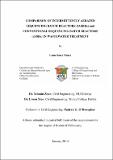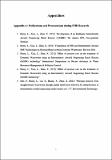| dc.description.abstract | Increasingly stringent discharge standards, increased water usage, variations in wastewater characteristics and climate change have resulted in increased difficulty in achieving cost effective wastewater treatment. The overall aim of this study was to compare the performance of an intermittently aerated sequencing batch reactor (IASBR) technology and a conventional sequencing batch reactor (cSBR) technology under various scenarios in terms of operation effectiveness and flexibility.
During this research, laboratory-scale IASBR and cSBR systems were constructed in the Environmental Engineering Laboratories at the National University of Ireland, Galway to treat synthetic domestic wastewater and real municipal wastewater. In addition mathematical modelling was used to further investigate and compare the IASBR and cSBR operations. The specific objectives of this research included: (1) to compare the treatment effectiveness of IASBR and cSBR operations; (2) to develop predictive GPS-X simulation models capable of predicting the efficiency of cSBR and IASBR systems in the treatment of synthetic domestic and real municipal wastewaters; and (3) to develop a predictive GPS-X simulation model to assess the IASBR technology in slaughterhouse wastewater treatment, in comparison to the cSBR technology.
Synthetic domestic wastewater was treated to observe and compare the effectiveness of the IASBR and cSBR operations at two aeration rates, 0.8 L air/min and 1 L air/min, for a low strength wastewater. The laboratory results show that at the aeration rate of 1 L air/min nitrification was improved but denitrification and phosphorus removal declined due to the increased dissolved oxygen concentrations present in the react period. The cSBR data was then utilised to validate a predictive GPS-X simulation model. The mathematical modelling shows that the IASBR technology can offer safer levels of treatment than the cSBR technology. The heterotrophic biomass concentration was higher in the cSBR but phosphorus accumulating organisms (PAOs) and autotrophic biomass concentrations were higher in the IASBR. Converting the operation sequence from a cSBR to an IASBR promoted the denitrification and phosphorus removal processes.VII
The performance of the IASBR operation was examined for the treatment of real municipal wastewater in order to confirm the previous observations of the IASBR operation for the treatment of wastewater which had received primary clarification treatment, referred to as primary clarifier effluent (PCE), or by-passed primary clarification treatment, referred to as primary clarifier influent (PCI). The IASBR technology achieved better performance, in particular in nitrogen removal, when treating PCI wastewater due to the higher influent chemical oxygen demand/nitrogen (COD/N) ratios. Mathematical modelling indicated that during the treatment of the PCE wastewater heterotrophic and autotrophic biomass concentrations were reduced, in comparison tothe PCI wastewater treatment. The shock load impact due to the conversion of the influent from PCE to PCI wastewater, and vice versa, was also investigated. It was observed that the effluent quality was improved when converting influent wastewater from PCE to PCI. | en_US |



